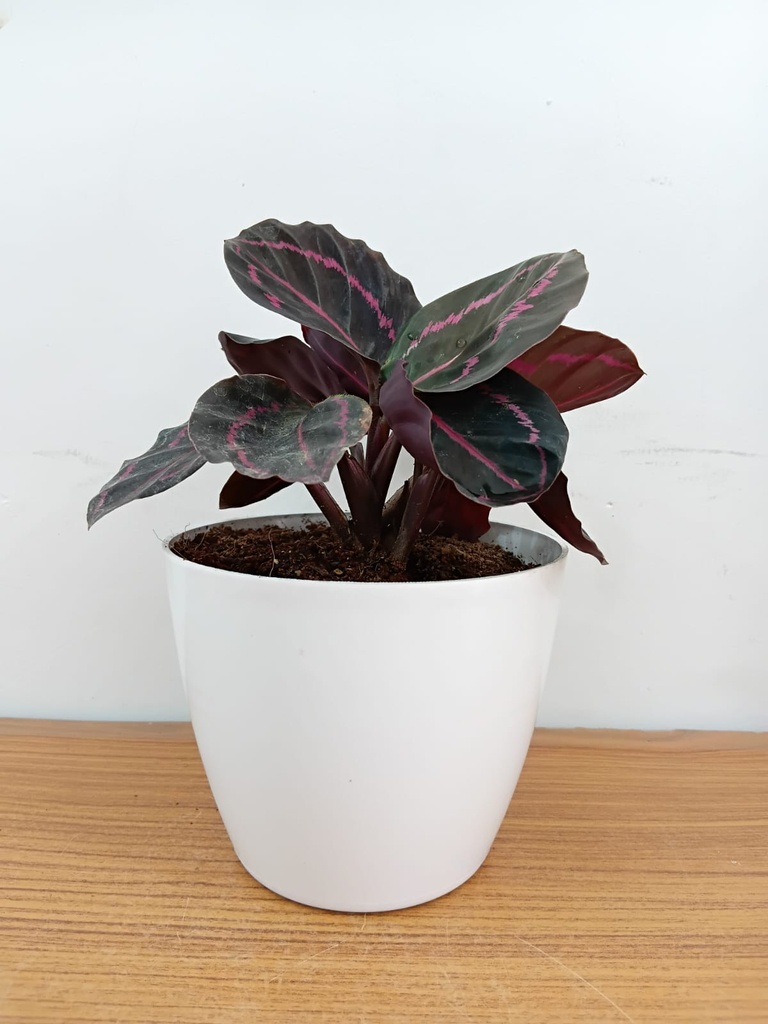Product Specifications
The Calathea Dottie is a truly captivating houseplant, immediately drawing attention with its uniquely patterned leaves. Its foliage presents a striking contrast, featuring deep, almost black-green leaves that are beautifully accentuated by vivid pink markings. A bright pink midrib runs through the center of each leaf, and a delicate pink outline traces the leaf's edges, creating a visually dramatic effect. Adding to its allure, the undersides of the leaves reveal a rich, purplish-burgundy hue, further enhancing the plant's visual depth. The leaves themselves are typically rounded or oval, with a slightly wavy texture, giving them a soft, velvety appearance. Like other Calatheas, the Dottie displays a fascinating "prayer plant" behavior, where its leaves fold upwards at night, resembling hands in prayer, and then unfold during the day. This plant maintains a compact, clumping growth habit, making it an ideal choice for indoor settings. Its overall appearance is one of exotic elegance, adding a touch of tropical sophistication to any space. While it may occasionally produce small white flowers, it's primarily admired for its stunning and dramatic foliage.
Aesthetic Enhancement:
- The most prominent benefit is its stunning visual appeal. Its dark, patterned leaves with vibrant pink markings create a focal point in any room, enhancing the decor.
- The "prayer plant" movement of its leaves adds a dynamic and engaging element.
Air Purification:
- Like many houseplants, Calathea Dottie contributes to improved indoor air quality. Plants naturally absorb carbon dioxide and release oxygen.
- They can also help to filter out certain airborne toxins.
Increased Humidity:
- Through transpiration, plants release moisture into the air, which can be particularly beneficial in dry indoor environments. This can help to alleviate dry skin and respiratory issues.
Stress Reduction:
- The presence of indoor plants has been shown to have a calming effect, reducing stress and promoting a sense of well-being. Caring for plants can also be a therapeutic activity.
Improved Indoor Environment:
- Adding natural elements to indoor spaces has been shown to generally improve the feel of those spaces.
- Light:
- Calathea Dottie prefers bright, indirect light. Direct sunlight will scorch the leaves, causing them to fade and brown.
- An east- or north-facing window is often ideal.
- Watering:
- This plant requires consistently moist soil, but not waterlogged.
- Water when the top inch of soil begins to dry.
- Use distilled, filtered, or rainwater, as tap water can contain minerals that cause leaf browning.
- Humidity:
- High humidity is crucial for Calathea Dottie.
- Consider using a humidifier, placing the plant on a pebble tray with water, or keeping it in a humid room like a bathroom.
- Regular misting can also help.
- Soil:
- Use a well-draining, peat-based potting mix.
- This helps retain moisture while preventing waterlogging.
- Temperature:
- Calathea Dottie prefers warm temperatures, ideally between 65-85°F (18-29°C).
- Avoid cold drafts and sudden temperature changes.
- Fertilizing:
- Fertilize every 2-4 weeks during the growing season (spring and summer) with a balanced, water-soluble fertilizer.
- Reduce or stop fertilizing during the winter.
- Pests and Diseases:
- Watch for pests like spider mites, mealybugs, and aphids.
- Overwatering can lead to root rot.
- Additional Considerations:
- Calatheas are known for their "prayer plant" behavior, where their leaves fold up at night.
- It is very important to use water that is not to heavy in minerals. Tap water can cause brown crispy edges on the leaves.

